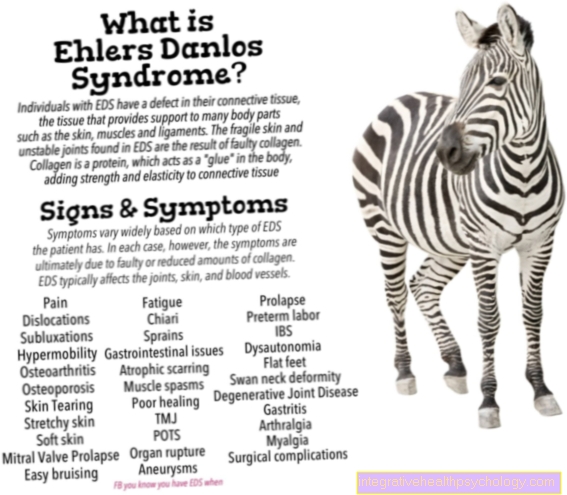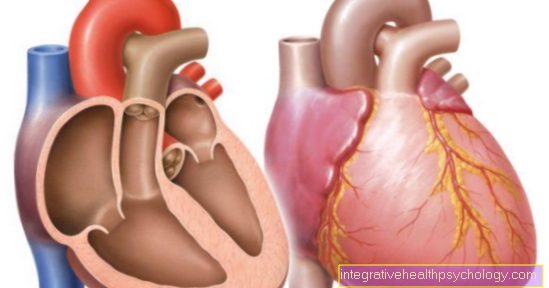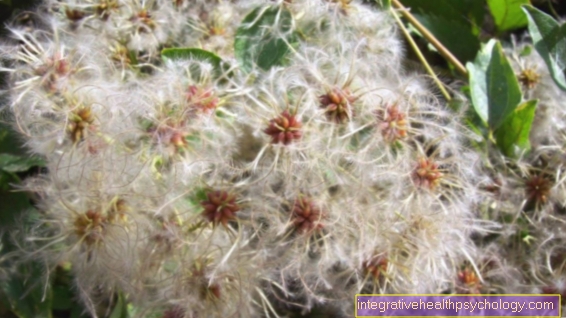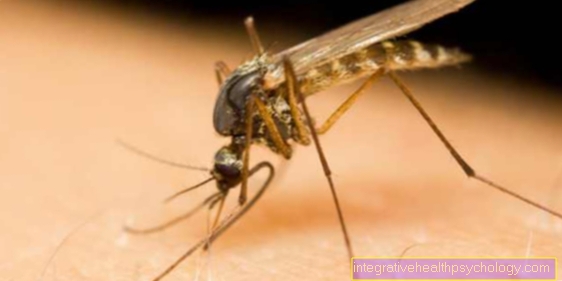inhalation
introduction
The word inhalation has its origin in Latin and means something like "to breathe in". During inhalation, droplets are inhaled and transported into the upper respiratory tract and, in some cases, into the lower respiratory tract. Inhalations are widely used, for example, for colds. They serve to dissolve the mucus.
In the typical inhalation of steam, relatively large droplets are inhaled. Due to their size, they only reach the area from the mouth and throat to the vocal folds. This type of inhalation is primarily used to moisten the dry mucous membranes.

Performing an inhalation
Inhalation can be done with simple means. The oldest variant is probably the one with a pot of hot water and a towel over your head. The water should not cook but about 60-80 ° C to be warm. Alternatively, you can buy simple plastic inhalers for little money in drug stores and pharmacies. Here, warm water is poured in at the bottom and inhaled through the opening.
Essential oils such as thyme, sage or lavender. Here you put a few drops (about 3-6) in 1-2 liters of water, depending on the instructions. Chamomile or sage tea can also be added. Ideally 1-2 tablespoons per 2 liters. The simplest variant is inhalation with Table salt. About 2 tablespoons of salt can be added to 2 liters. Can be inhaled several times a day. The respective duration also depends on the additives. 10-15 minutes with table salt and teas, only 5-8 minutes when adding essential oils.
What inhalation devices are there?
In inhalation therapy, various inhalation devices have become established that have different modes of action and are suitable for various diseases. The therapeutic spectrum of inhalation can range from simply moistening the upper airways to acute use in diseases of the lungs, which is why a certain inhalation device must be specifically tailored to a disease. Most commercially available devices aim to ensure that the active ingredient also reaches the bronchi and smaller parts of the lungs.
These include jet or ultrasonic nebulisers based on inhalation with mist. The nozzle nebulizer converts the active ingredient into a fine mist using compressed air, whereas the ultrasound works by means of rapid mechanical vibrations. Both methods can be provided with different active ingredients and thus used to treat colds, tonsillitis, pneumonia, asthma or bronchitis.
In the treatment of respiratory diseases such as bronchial asthma or COPD (chronic obstructive pulmonary disease), sprays that are inhaled are used. The sprays are usually available in the form of so-called metered dose aerosols and are often also provided with a spacer. This ensures that the droplets to be inhaled are greatly reduced in size. This enables the droplets to travel significantly further into the airways than pure steam.
They pass through the windpipe into the bronchi. This is important because they have to attack there in particular to alleviate the symptoms of asthma or COPD.
Jet or ultrasonic nebulizers can also be used for these respiratory diseases. For this purpose, suitable drugs can be added to the mist, which are then inhaled.
So-called “spacers” can be used to facilitate inhalation. They are attached between the mouth and the inhalation device and simplify the coordination between spray and inhalation. They are used in particular in the treatment of COPD in combination with metered dose aerosols. The metered aerosols can produce particularly small droplets of liquid with fine spray heads, which enable extremely deep penetration into the lungs. This depth of penetration may be required for the introduction of anti-inflammatory agents in COPD.
These have the advantage that the droplets are atomized and thus reduced in size, so they get deeper into the airways than with pure steam inhalation. This can be useful for bronchitis, for example. Nozzle or ultrasonic nebulizers usually do not produce warm steam, but rather mist that is not heated. This can be beneficial for children, for example.
For children there are also steam inhalers for classic inhalation, which are a more pleasant way of moistening the mucous membranes.
Who will benefit from an inhalation mask?
Occasional inhalations as part of colds can easily be carried out with a bowl and a cloth. A Inhalation mask has the same effect, but is easier for many to use and is a more pleasant alternative, especially for children.
The mask covers the mouth and nose and can be attached with a rubber band. It can therefore be easily attracted to children in particular, without having to correct them. With classic inhalation, the water vapor reaches the mouth and nose as well as the face and occasionally the eyes. This can be very uncomfortable and even lead to unwanted irritation of the mucous membranes.
For this reason, the purchase of an inhalation mask is particularly advisable if there is an above-average rate of therapy. An inhalation mask can also be used for the treatment of chronic asthma, protracted bronchial or pneumonia, as well as for COPD. It makes inhalation easier, can transport the active ingredients more reliably to the mucous membranes and can be combined very well with nebulisers.
What inhalation solutions are there?
The basis of a conventional inhalation for moistening the mucous membranes consists of water vapor.This already moistens the mucous membranes and alleviates irritation, which can alleviate the symptoms of colds, inflammation of the mucous membranes and bronchitis. Herbs, oils and other additives are often used to increase the effect. Popular additives are included
- Chamomile,
- Mint,
- Eucalyptus,
- Mountain pine
- but also salt.
Essential oils should only be used carefully as they can irritate the mucous membranes themselves.
Chronic diseases of the respiratory tract and the lungs often require drug therapy via inhalation. This also requires more professional inhalation devices to ensure that the active ingredient reaches the affected part of the lungs.
Depending on the severity of the disease, asthma requires inhalative therapy with bronchodilator drugs or anti-inflammatory agents similar to cortisone. The classic asthma spray transports a short-acting active ingredient into the bronchi, which relaxes them and can quickly interrupt the asthma attack by expanding the bronchi. In the treatment of COPD, cortisone-like agents often have to be inhaled in order to stop the inflammation of the airways.
Inhalation with table salt (NaCl)
Table salt is often added to simple steam inhalation. You can do that, but the effect is marginal as the salt dissolved in the water hardly gets into the steam and therefore has no effect. In the case of inhalation devices with a nebulizer, a significantly larger proportion of the salt gets into the steam and thus also into the airways. It makes most sense to add 0.9% saline solution to produce an isotonic saline solution. This is available from the pharmacy. The addition of salt moisturizes the irritated airways in the case of colds and coughs, as well as dissolving mucus.
Inhalation with chamomile
Chamomile is the most popular addition to a classic inhalation treatment for colds or inflammation of the bronchi.
The chamomile can help the water vapor to liquefy the stubborn mucus that has settled in the mucous membranes and to reduce irritation of the mucous membranes. Chamomile also has anti-inflammatory and antibacterial effects, so that healing is promoted. It can also have an antispasmodic effect, reducing the urge to cough and breathing difficulties associated with bronchitis and a persistent cough.
Inhalation for colds and coughs
The classic cold can be triggered by viruses and bacteria and includes coughing, runny nose, hoarseness and exhaustion, feeling weak and possibly fever. In contrast to bronchitis, the affected airways are often above the vocal folds and include the nose, sinuses, throat and windpipe. With classic inhalation, these sections of the airways can easily be reached by the droplets of water vapor without the use of nebulizers.
Inhalations are often used for colds with or without a cough. In particular, to sufficiently moisten the somewhat dried out mucous membranes and to achieve a decongestion of the mucous membranes of the nasal and pharynx. Inhalation with a simple plastic steam inhaler, which can be purchased for little money in the pharmacy or drugstore, is often sufficient for this.
Here, too, pure steam therapy can already achieve good results and sufficiently moisten the mucous membranes. But additives such as anti-inflammatory herbs or essential oils are popular additions to classic inhalation therapy. Salt is also often added, although with classic inhalation it does not go into the water vapor and therefore cannot have any effect.
Read on under:
- cold
- Home remedies for a cold
- What helps against coughs?
Inhalation for bronchitis
Bronchitis is an inflammation of the upper respiratory tract, which occurs especially in the winter months caused by viral and bacterial pathogens. It can be accompanied by hoarseness, fever, sore throat, cough and severe irritation of the mucous membranes, which makes them very uncomfortable. As a rule, bronchitis heals within a few days to a few weeks.
With bronchitis, it is necessary that the inhaled droplets reach the bronchi. This is not possible with normal steam inhalation. You need an inhalation device with a nebulizer. This ensures that the droplets are sufficiently crushed so that they can penetrate further into the airways. Steam inhalers as well as ultrasonic and jet nebulizers are suitable for this. Inhalation can have an expectorant effect and reduce the urge to cough, but not least also serves to increase well-being through inhalation of the warm, moist air.
Find out more at: Bronchitis
Inhalation for COPD
COPD is a chronic lung disease that is associated with inflammation of the small airways and often requires lifelong treatment. The disease is divided into 4 stages according to the symptoms and the damage to the lungs, which are associated with different inhalative and medicinal therapies.
At the beginning of the disease, as in the case of asthma, an inhalation of short-acting bronchodilator drugs is often sufficient, which is used if necessary. In later stages, long-acting means to relax the bronchi can follow. In severe cases, therapy with so-called "glucocorticoids", which are similar to cortisone, must follow. They can also be administered via inhalation with metered dose aerosols and can also develop their effect in the deep areas of the lungs.
Learn more at: chronic obstructive pulmonary disease (COPD)
Inhalation in the baby
Especially with (small) children there is one normal inhalation from steam often not the method of choice. There is the danger injury from the hot water and the warm steam in the sense of scalding or irritation of the mucous membranes. In addition, most children find it uncomfortable to inhale warm steam. As an alternative, ultrasonic or jet nebulisers, for example, are used, which produce mist that is not heated. This often makes it easier for children to inhale. These devices are particularly suitable for children with chronic respiratory diseases such as bronchial asthma.
Steam inhalers can be used for children with frequent colds and / or coughs. These produce warm steam, which is protected from leakage by attachments for children. In the case of children, essential oils should usually not be added when inhaling. It is better to add one low percentage saline solution which is available in the pharmacy. But inhalation is also effective without any additives.
Recommendations from the editorial team
You might also be interested in these topics:
- asthma
- Asthma spray - what to watch out for!
- bronchitis
- chronic obstructive pulmonary disease (COPD)
- cold
- hay fever
- Cough / smoker's cough / cough suppressant
- Emergency spray for asthma



















.jpg)









